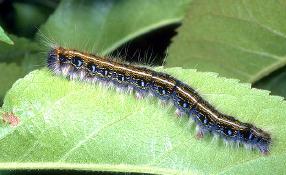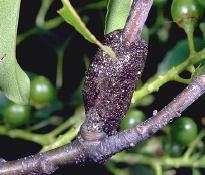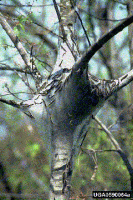By Nellie Brown

Eastern tent caterpillar. Photo from Univ. of KY
At this time of year, as the trees are leafing out, insects that feed on them are showing up as well. One of these is the eastern tent caterpillar (Malacosoma americanum).
The adult moth is rarely seen, but the larval caterpillars create webs in the limb crotches of the trees on which they are feeding – close to or on the trunk. Usually these trees are in the rose family, including but not limited to cherries, plums, crabapples, hawthorns, apples, peaches, and pears.
When the insect population on a tree becomes large, it can significantly defoliate the tree and create large, unsightly webs. Most healthy trees quickly re-grow their leaves, but weak and unhealthy trees will be stressed by these insect pests.
Life cycle
Eastern tent caterpillars complete their life cycle in about a year. The caterpillars hatch in the spring and form their characteristic webs. They feed mostly in the early morning, evening, and at night, and hide inside the web during the heat of the day.

Egg mass. Photo from Univ. of KY.
After feeding on a host tree through several larval stages, the grown caterpillars crawl off to find a place to form a silky cocoon and pupate. When the adult moths emerge from the cocoons in mid to late summer, they mate and females lay egg masses on the twigs of host trees.
Control measures
Removing the shiny egg masses in the fall will reduce problems the following spring.

Photo from Univ. of KY
Wild birds will snap up the caterpillars to feed their young, and tearing open the somewhat sticky webs with a twig will improve their access to these pests. If you aren’t concerned about feeding the local bird population, open the web and dowse it with a bucket of soapy dishwater.
Biological control agents such as B.t. (Bacillus thuringiensis kurstaki) can be effective when the caterpillars are small. Larger caterpillars will require a more potent insecticide such as a carbaryl, like Sevin. However, after they are about a month old and in their final larval stages, insecticides have almost no effect.
Do not use fire or blowtorches to control these insects. The damage done to the tree by fire will be far greater than damage from the caterpillars.
Similar species
I have also seen a close relative of the eastern tent caterpillar in Missouri. Forest tent caterpillars (Malacosoma disstria) are a minor pest of forest trees such as oaks, and rarely cause significant issues.
Eastern tent caterpillars are often confused with fall webworms, but the latter usually don’t become noticeable until mid to late summer and their webs are found at the end of limbs, not in the crotches.
Nellie Brown has worked in the green industry for over fifteen years, first as a nursery inspector for the Missouri Department of Agriculture, now as an independent consultant and certified arborist. She helps people solve their insect and disease problems with their trees, garden and home. Her website is: www.nelliebrownconsulting.com.


Thank you Nellie. I appreciate the info.
Nellie, Sometimes when I’m teaching at SNR we pass a tree(s) with the tents. I tell the kids they’re nurseries. Mom knew she wouldn’t be there when her “kids”, the caterpillars, were growing up. So she gave them a place where they could be protected at night but could crawl out the next morning and have a good meal.
Marilyn